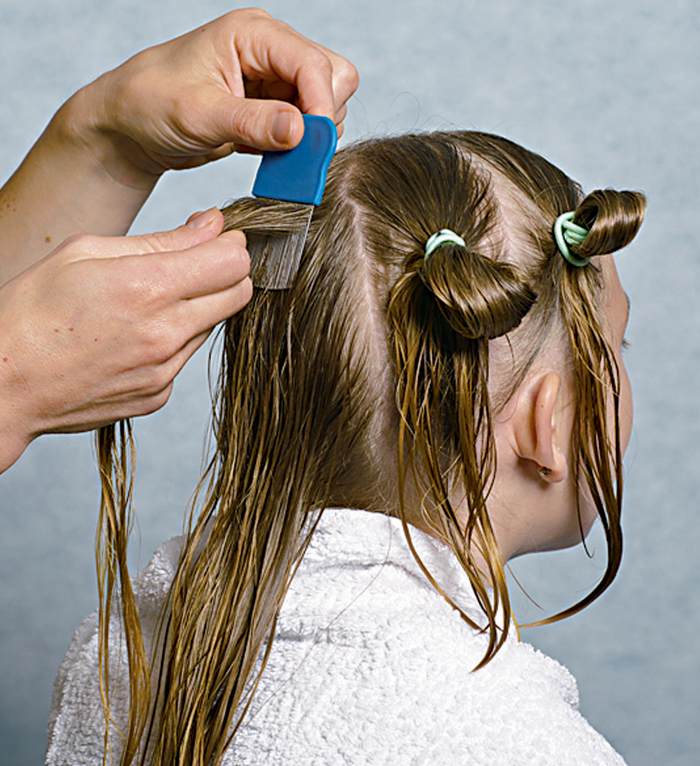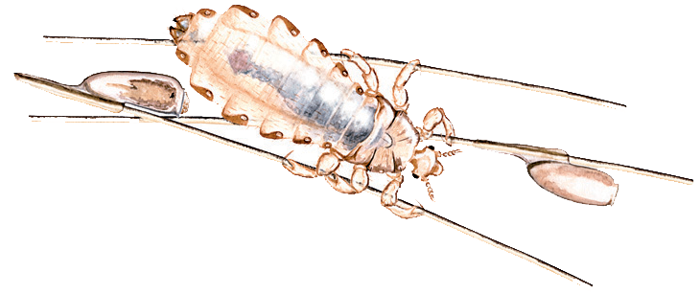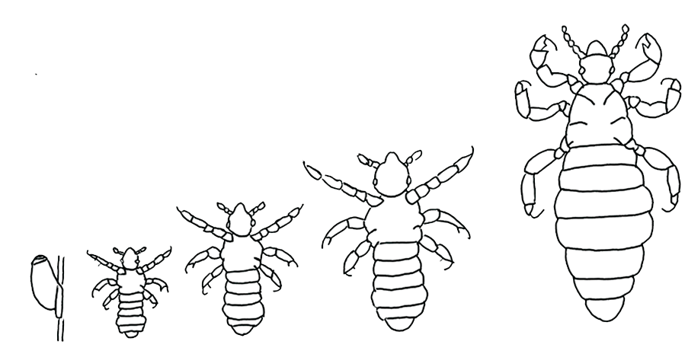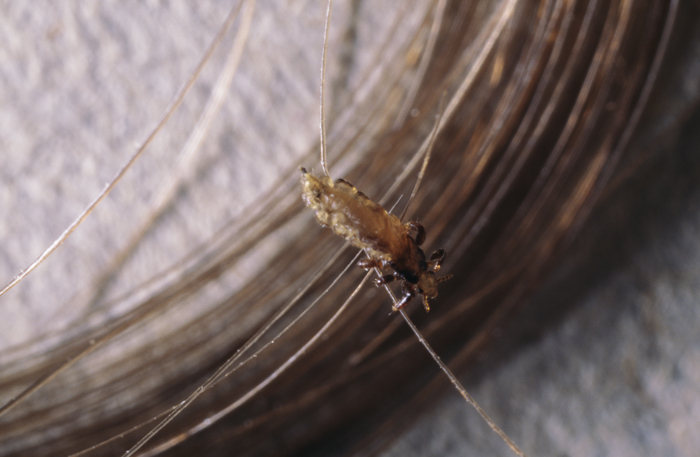How do head lice spread?
Head lice are transmitted when head lice, usually adults, crawl from one person to another when heads are held close together. Lice cannot jump but they crawl between hair strands. Once lice come away from hair, it is unlikely that they will re-establish themselves on a new head. They quickly become weak and survive for only 1-2 days away from a head.
Both adults and children can have head lice regardless of their hair type or personal hygiene. Head lice survive in hair that is washed often or seldom.
Symptoms of infestation
An itchy scalp is a common sign of head lice. Louse saliva contains substances that may cause itching when they enter the skin. However, not everyone with lice experiences itching or it can take time for it to start. It is therefore important to check regularly, regardless of whether or not you have itching. Other symptoms of lice include sores and scalp infections caused when lice bites are scratched.
How to check for head lice

Illustration: Lene Solbakken
- Use a fine-toothed lice comb (most commonly used method in Norway).
- Comb systematically and thoroughly through all the hair, from scalp to hair tip. In this way, you can find and remove lice that you would not notice with a normal comb, eyes and fingers.
- Before using the comb on others, wash it thoroughly at 60 ºC or freeze it for at least four hours to prevent infestation.
Wet or dry hair?
You can check for lice in either wet or dry hair, but we recommend wetting the hair and preferably adding conditioner. The lice do not move as much and they attach more easily to the lice comb.
Head lice check in wet hair:
- Lay a white towel over the shoulders when combing wet hair and check the towel and comb for lice. Lice are small and a magnifying glass can be useful.
- Wipe the comb on paper frequently to check for lice. Lice will dry within a few minutes, and you will see them move.
Head lice check in dry hair:
Some people prefer to check for lice in dry hair. Lice move in dry hair and they may therefore be easier to spot, at least if there are many. However, combing dry hair creates static and lice may be thrown from the comb back into the hair.
- The person being combed should bend over a big white sheet and comb from the scalp and down towards the sheet.
Finding head lice eggs
Combing can also find lice eggs. They stick so well to the hair strand that the hair often breaks during combing, with the egg still attached. Finding eggs alone is not a sure sign of an ongoing lice infestation as they may have hatched or died. Live head lice must be detected for a certain diagnosis. The egg's location on the hair shaft may help to determine the time of infestation. Since eggs are laid mainly near the scalp and hair grows about a centimetre per month, eggs nearer the scalp will have been laid more recently than those further out.
How often should you check for lice?
A major reason for not being able to get rid of lice in a local environment is that lice checks are performed all too infrequently. If the frequency increases, head lice are detected quicker and fewer will wander round unawares with head lice and potentially infest others.
The Norwegian Institute of Public Health recommends that families check everyone in the household with a lice comb at least once a month. You should also carry out a thorough lice check as soon as you hear about lice in the contact circle or suspect an infestation.
To prevent infestation, all parents should check their children at the start of the school year and after holidays abroad if the children have been in contact with local residents. It is the parent’s responsibility to check and treat their children for head lice but schools and childcare centres can encourage parents to check their children at the start of the school year.
School and childcare centres
There is no need to send children home from childcare or school for having head lice. They have probably had them for a long time, so a few hours make little difference. They could wear a headscarf or other headgear to prevent infesting others, and their parents should inform the contact circle that they have found lice. When the child comes home, treatment should begin the same evening. The child can go to childcare or school as normal. No-one should stay away at home because of head lice.
Inform the childcare centre or school, and contact circle that your child has head lice, so they can also check for lice and avoid infesting others. The school or childcare centre should inform other parents or guardians that lice have been detected within the school grade/department.
Head Lice (brochure in several languages)
Treatment
Head lice can be combated with lice treatment from the pharmacy, by combing the hair or by shaving the hair shorter than 0.5 cm.
Everyone with head lice should be treated as promptly as possible with one of these methods to minimise the infestation risk. If others in your family or contact circle have lice, they must be treated simultaneously to prevent further infestation and re-infestation.
Check the hair weekly for three weeks after the last treatment to see if the head lice are gone.

Illustration: Lene Solbakken
Pediculicides
In Norway, about 90 per cent of people with head lice are treated with delousing agents, also known as pediculicides. Only people with head lice should use these products, and it is important to follow the enclosed instructions carefully.
Most of the agents contain the active ingredients dimethicone and/or plant oils. Dimethicone is a silicone-based substance that coats and kills the lice. Dimethicone products are proven to be effective and are therefore recommended ahead of plant oil products where the effect is less well documented. Pediculicides containing the active ingredient permethrin are not recommended due to resistance among head lice.
Pediculicides are less effective against lice eggs, so treatment usually has to be repeated after 8-10 days, depending on the product used. During this time, surviving eggs will have hatched, but the new lice will not have reached sexual maturity yet so they cannot lay new eggs.
Combing
A lice comb can be used to combat lice. Not many people choose this treatment method, probably because it is time-consuming. Comb wet hair systematically and thoroughly every day or every second day for 12-14 days. Check the hair weekly for three weeks after the last treatment.

Lice eggs firmly attached to strands of hair.
Illustration: Hallvard Elven
Shaving
Lice cannot survive on hair shorter than 0.5 cm. Shaving is a good treatment option, if having short hair for a period is acceptable. Please note that the lice will crawl among hair clippings after shaving. Some lice will also attempt to cling on to stubble. Use a lice comb to remove them.
Treatment of objects
It is possible for lice to spread via combs and brushes and these should be washed or frozen if there are lice in the household. Freeze combs and brushes to -20 ºC for at least four hours or wash them at 60 ºC.
Transmission via other objects is unlikely. It is not necessary to wash clothes, furniture or the house itself if somebody has head lice. After lice treatment, washing bed linen to remove any old lice and their excrement may be done.

Illustration: Preben Ottesen
